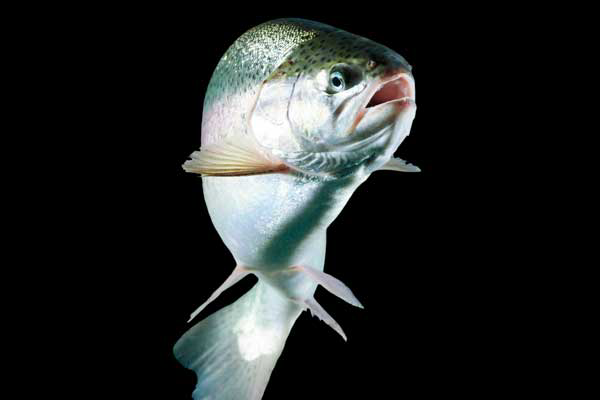How do mycotoxins affect fish?

Aquaculture is an important business, but research on the occurrence and prevention of mycotoxins in fish feed is limited and species sensitivities remain unknown. However, the knowledge on this topic is increasing rapidly.
Since more than 400 different substances are known to be produced by different fungi it is not surprising that fish are commonly exposed to a huge variety of these naturally occurring substances. So far five major mycotoxin classes have been established: aflatoxins, ochratoxins, fumonisins, trichothecenes, and zearalenone but several other mycotoxins which are not included in these major classes also gained attention in fish nutrition recently.
We are able to detect more mycotoxins due to recent developments of new and more specific detection methods and therefore also the number of reports on mycotoxin contaminations in fish increases. Mycotoxins, such as moniliformin, cyclopiazonic acid, citrinin and sterigmatocystin have been detected in feed for other farm animals, but have rarely been shown to occur in fish feeds up to now although their presence is probably unavoidable in fish nutrition. At low levels, mycotoxins have even been identified in surface waters but the main exposure of fish occurs via feed. Accordingly, raw materials that can be used for production of feeds in aquaculture have been reported to contain several mycotoxins including aflatoxins, zearalenone, deoxynivalenol (DON), citrinin, ochratoxin-A, fumonisins, moniliformin, Alternaria toxins and T-2 toxins.

The increasing number of publications related to fish feed contamination and the consequences for fishes shows that research on fish and mycotoxins is increasing.
More plant material in fish feed
Contamination of fish feeds with Penicillium and Aspergillus species may lead to the occurrence of toxins such as aflatoxins, ochratoxins, patulin, citrinin, cyclopaizonic acid, sterigmatocystin and gliotoxin which are produced mainly during storage of both feed ingredients and finished feeds. In contrast, Fusarium toxins such as DON, nivalenol, zearalenone, T-2 toxin, fumonisins, moniliformin and fusaric acid are formed on the field crops before harvest. The occurrence of mycotoxins strongly depends on environmental factors. Humidity, temperature, environmental conditions and climate fluctuations increase the threat of mycotoxin contamination, and thus global climate change will intensify the issue. Nevertheless climatic modelling has already successfully been used to assist in managing aflatoxin and DON contaminations in materials that also are in use for fish feed production (e.g. peanuts, maize and wheat). Reports on mycotoxins in fish feed are also expected to increase due to the fact that commercial feeds for aquaculture often contain high amounts of fishmeal (FAO, 2012), but the growing aquaculture sector decreased the fish meal stock worldwide and the decreasing availability of fish resources led to the need for alternative protein resources to replace fishmeal in these feeds. Thus, cereals are increasingly used for production of fish feed. Generally feed ingredients of plant origin are more intensely contaminated with mycotoxins than fish meal and fish oil which further increases the probability of mycotoxin contamination in fish feed.
Current state of research
The increasing number of publications related to fish feed contamination and the consequences for fishes shows that research on fish and mycotoxins is increasing. On the one hand, knowledge on the occurrence of mycotoxins in fish feeds is increasing. On the other hand, some studies even reported mycotoxin contamination levels in muscle or liver tissue for some fish species as a consequence of experimental feeding of artificially or naturally contaminated feeds. In some cases the retention of mycotoxins such as aflatoxins in edible parts of fish might even pose a risk to consumers. Most recent studies concentrated on the effects of mycotoxins on fishes with respect to growth performance, developmental effects, immune impairment, haematological and histological changes. In addition, tumour incidence and tumour promotion has been linked to the influence of several mycotoxins such as aflatoxins, fumonisins and zearalenone.
Signs of mycotoxicosis
Fish farmers would like to know what the main signs of mycotoxicosis are and how a fish farmer could detect a mycotoxin infection. However, depending on their chemical structure, mycotoxins show diverse effects on fish and a simple answer is not at hand. Typical acute signs of mycotoxin exposure depend on type and the concentrations of mycotoxins in feed, but also on exposure duration, and age and species of fish. Thus mycotoxins can induce several disorders in fish including biochemical, functional and morphological disorders and in severe cases even mortality. Nevertheless more chronic signs of impairment of fish by mycotoxin may be observed as reduced weight gain, effects on the immune system, disturbance of nutrient metabolism, chronic inflammation, tumours, lesions, and damage to kidney and liver tissue.
Species sensitivities
The accumulating research raises the question of differences in species sensitivity towards mycotoxins. An increasing number of fish species has been used to investigate the effects of different mycotoxins during the last few years including rainbow trout, Atlantic salmon, common carp, gibel carp, zebrafish, beluga, sturgeon hybrids, channel catfish and Nile tilapia. However, the effects of the same mycotoxin on two different fish species under exactly the same experimental conditions have not yet been investigated which makes it difficult to judge species differences in sensitivity to mycotoxins. So far it was often assumed that salmonids are very sensitive to mycotoxins, but recent research showed that depending on the biological response that has been investigated, also cyprinids can be very sensitive to feed-borne mycotoxins. Nevertheless further research is needed to clarify the issue of species-specific sensitivity to certain mycotoxins.
Strategies for prevention
One strategy to mitigate the negative effects of possible mycotoxin contamination would include the selection of proper ingredients for subsequent feed production. Furthermore, the use of appropriate drying methods and improved storage conditions can certainly minimise the formation of mycotoxins in grains independent of the location where they take place, i.e. on a farm, in a warehouse or during transport. Possible strategies for mycotoxin reduction during growth, harvest, storage and processing of crops have been reported. For example, improved processing of feeds e.g. hot extrusion may be effective to reduce contamination with mycotoxins such as fumonisins. In contrast, studies on the effects of high temperatures and high pressure on DON concentrations during the production of food and feed yielded contradicting results. These treatment options should now be investigated more intensely for other mycotoxins. Besides this, some research has focused on strategies of biological detoxification of mycotoxins, the use of different sorbents or the use of genetically modified crops for feed production in order to achieve less mycotoxin contamination in feed. However, given the current trends in fish feed formulations, production technologies and storage, many more publications demonstrating improved aquaculture yields after addressing mycotoxin issues can be expected. Increasing the knowledge on mycotoxins in fish will influence our future strategies for fish nutrition.
[Source: Managing mycotoxins, 2014]
References are available on request











